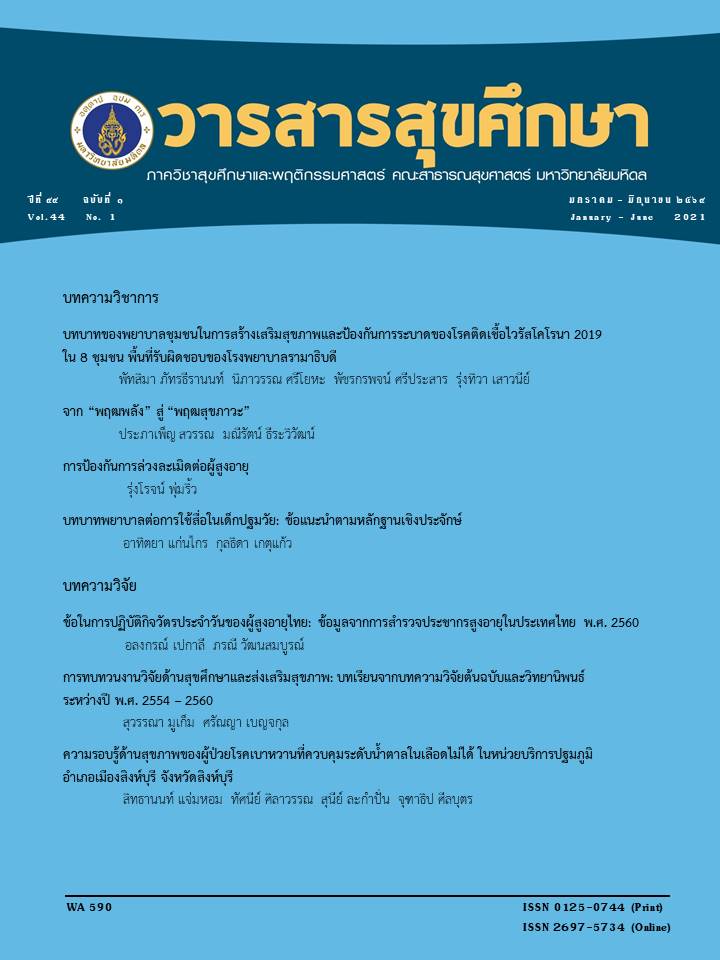The Effectiveness of a Behavioral Promoting to Promote the Use of Hearing Protection Devices among Worker Industry
Main Article Content
Abstract
The hearing protection devices (HPDs) is important for preventing noise induce hearing loss particularly when other exposure control measures could not be applied, however the usage rate was quite low. This study aims to explore the effectiveness of the behaviour promoting program regarding HPDs use among industrial worker. It is a quasi-experimental research with one-group pretest-posttest design. Participants were 33 workers from the department of grid and paste at battery factories in Saraburi province. The program was applied from health belief model as guidance for activities of HPDs use promoting. Study period was 8 weeks. Data collection composed of questionnaire, observation, audiometric test and noise exposures monitoring. The data were analysed using descriptive and inferential statistics, i.e. Paired t-test with respect to the statistical significance level 0.05.
After the program implementation, the mean scores of the knowledge regarding noise hazard and how to use HPDs, perceived risk of hearing loss, perceived benefits, perceived barriers, and behavior of HPDs use were increased 38.11%, 28.28%, 17.65%, 42.62%, and 36.55% respectively. Moreover, temporary threshold shifts in right ear and left ear were decreased 44.13% and 55.01% respectively. In conclusion, activities in this study was practical and may be applied to similar target groups of workers.
Article Details
References
Hong O, Kerr M, Poling G, Dhar S. Understanding and preventing noise-induced hearing loss. Dis Mon 2013; 59:110-118.
The National Institute for Occupational Safety and Health (NIOSH) [Internet]. USA. 1997 [cited 2019 June 20]; Available from: https://www.cdc.gov/mmwr/volumes/67/wr/mm6708a2.htm.
The Bureau of Occupational and Environmental Diseases. Ministry of Public Health. [Internet]. THAI. 2017 [cited 2019 June 20]; Available from: http://envocc.ddc.moph.go.th/uploads/Occupational%20Health/MOH%20SEM% 2014/1/1.4%20situation.pdf. [In Thai]
World Health Organization. Global costs of unaddressed hearing loss and cost-effectiveness of interventions: a WHO report [Internet]. USA. 2017 [cited 2019 June 20]; Available from: https://apps.who.int/iris/bitstream/10665/254659/1/9789241512046-eng.pdf.
Apiradee Sriopas, Robert S. Chapman, Saravudh Sutammasa, Wattasit Siriwong. Occupational noise-induced hearing loss in auto part factory workers in welding units in Thailand. J Occup Health 2017; 59: 55-62. [In Thai]
Surisa Tonchumpo, Chawapornpan Chanprasit, Wanpen Songkham. Predicting factors of hearing protection devices use among workers in Large Lumber Mill. Journal of Health Science 2018;17(1):31-39. [In Thai]
Daniell WE, Swan SS, McDanie MM, Camp JE, Cohen MA, Stebbins JG. Noise exposure and hearing loss prevention programmes after 20 years of regulations in the United States. Occup Environ Med 2006;63:343-51.
Morata TC, Fiorini AC, Fischer FM, Krieg EF, Gozzoli L, Colacioppo S. Factors affecting the use of hearing protectors in a population of printing workers. Noise & Health 2001;4(13):21-28.
Yahya S, Rahman A, Razali A, Rahman N, and Haque M. Satisfaction study of using hearing protection device among sawmill workers in Kuantan, Malaysia. International journal of Pharmaceutical research 2016;8(1):50-56.
Ntlhakana L, Kanji A, Khoza-Shangase K. The use of hearing protection devices in South Africa: exploring the current status in a gold and a non-ferrous mine. Occupational Health Southern Africa 2015;21(2):10-15.
Reddy R, Welch D, Ameratunga S, Thorne P. Development of the hearing protection assessment (HPA-2) questionnaire. Occupational Medicine 2014;64:198–205.
Tantranont K, Codchanak N. Predictors of hearing protection use among industrial workers. Workplace Health Saf 2017;65(8):365-71. [In Thai]
Bernard R. Fundamentals of Biostatistics. 5th ed. Duxbery Thomson Earning. 2000.
Panjit Pucchimkul. Effect of behavior change program on using the protective device against harmful noise of employees in Metal Manufacturing, Gateway Industrial Estate. [MN.S. Thesis in Occupational Health Nursing]. Chonburi: Faculty of Graduate Studies, Burapha University, 2010. [In Thai]
Lusk SL, Ronis DL, Kazanis AS, Eakin BL, Hong O, Raymond DM. Effectiveness of a tailored intervention to increase factory workers’ use of hearing protection. Nursing Research 2003; 52(5):289-295.
Liu Y, Yang M. Evaluating the effect of training along with fit testing on earmuff users in Chinese textile factory. Journal of Occupational and Environmental Hygiene 2018;15(6):518-526.
Supree Decha, Somkid Prabpai. The effectiveness of behavioural promoting program to promote increase personal protective equipment (PPE) using among solid waste collectors, Bang Mueang Tambon Municipality, Samut Prakan Province. Disease Control Journal 2018;44(1):30–37. [In Thai]
Janz NK, Becker MH. The health belief model: A decade later. Health Education and Prevention 1984;3(1): 1-47.
Ramakers GG, Kraaijenga VJ, Cattani G, van Zanten GA, Grolman W. Effectiveness of earplugs in preventing recreational noise–induced hearing loss: A randomized clinical trial. American Medical Association 2016;142(6):551-558.


